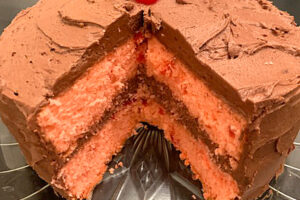The first time I had rum cake in Italy was in Venice in the 1970s. The waiter wheeled out a cart with a two-foot wide, ten-inch high dome-shaped mound covered in beautifully browned merengue. With an enormous spoon, he offered us capacious portions. It was more delicious than any Italian dessert I had tasted to that point in my life. I vowed to reproduce it at home.
Though I contrived a very respectable imitation of the Venetian version, over the years, my recipe has undergone many transformations. I abandoned the merengue for a stabilized whipped cream frosting, simply because it holds up better in the refrigerator. I abandoned the usual pastry cream for a much lighter Bavarian-cream filling, hence the term leggera. And I opted for a more typical butterless Italian spongecake for my base.

A Light Italian Rum Cake
The origin of the rum cake is extremely murky. Some claim that rum cake is an Italo-American invention. It’s so closely related to Zuppa Inglese as to be almost indistinguishable—the difference being it looks like a cake rather than a molded dessert. The term Zuppa Inglese, which translates to English soup, seems to be at the root of the controversy over the derivation. What could this enticing Italian pastry possibly have to do with English soup? The term is thought by some to come from its close resemblance to the English trifle, a dessert of liqueur-soaked cake layered with custard.
Giuliano Bugialli in his book The Fine Art of Italian Cooking claims the name derives from Alkermes di Firenze, a bright liqueur, whose bright red color is the same as that used in the British flag. This liqueur, difficult to find even in Italy, is made from a cochineal, a substance produced by a parasitic insect. Eeww! Though I’ve never come across this version, it uses the Alkermes in addition to rum.
Even the period of its first appearance is in question. Some claim that in the 16th century, the Duke of Este in Ferrara asked his cook to replicate the trifles he had feasted on while traveling in England. Others maintain it is a 19th-century invention, which was an attempt to make the many English tourists in Emilia-Romagna feel more at home.
Nonsense, say others: Duke Cosimo I de’Medici had his cook fashion the dessert, which he called Zuppa del Duca. It was only when the English became enamored of it that it developed the current name.

Sliced Rum Cake
Many Italians, who are very proud of their heritage, claim it has nothing to do with either soup or the English. The name derives from the word inzuppare, which means to sop, in other words soak with liqueur. Choose whichever version delights, and just enjoy the dessert.
To print or download the recipe, click here.




